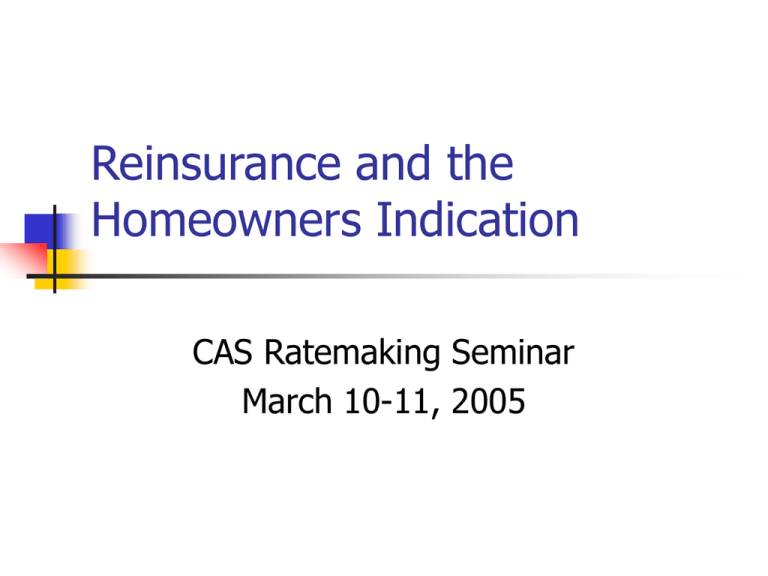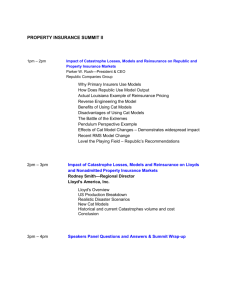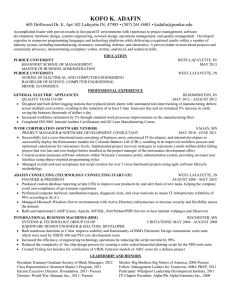Reinsurance and the Homeowners Indication CAS Ratemaking Seminar March 10-11, 2005
advertisement

Reinsurance and the Homeowners Indication CAS Ratemaking Seminar March 10-11, 2005 Agenda Brief Review of the Basics Catastrophe Excess Reinsurance Justification for Including Cost in Rates Components of the Reinsurance Premium Two Methods to Include the Cost of Reinsurance into the Rate An Example of the “Net Cost of Reinsurance Method” Miscellaneous/Related Topics The Basics of Reinsurance Reinsurance is simply insurance for insurance companies In exchange for a premium, the reinsurer agrees to assume all or part of some risk that had previously been assumed by the primary insurer. The Basics of Reinsurance Primary insurers purchase reinsurance for a variety of reasons, including: To To To To increase capacity stabilize underwriting results provide catastrophe protection obtain surplus relief Catastrophe Excess Reinsurance Under a catastrophe excess agreement, the reinsurer indemnifies the primary insurer for aggregate losses in excess of a given amount, called the retention, arising from a catastrophic event The reinsurer’s risk is generally limited to some amount A reinsurer may only indemnity the primary company for a percentage of loss in excess of the retention Catastrophe Excess Reinsurance - Example Assume a reinsurance contract provides coverage for 50% of $600MM of loss in excess of $400MM per catastrophic event If no event causes loss in excess of $400MM, the reinsurer pays nothing Catastrophe Excess Reinsurance - Example Assume a reinsurance contract provides coverage for 50% of $600MM of loss in excess of $400MM per catastrophic event If an event causes loss in excess of $1 billion, the reinsurer pays $300MM (= $600MM limit x 50%) Catastrophe Excess Reinsurance - Example Assume a reinsurance contract provides coverage for 50% of $600MM of loss in excess of $400MM per catastrophic event If an event causes loss between $400MM and $1 billion, the reinsurer pays 50% of the amount in excess of $400MM. Catastrophe Excess Reinsurance - Example Amount of Loss Primary Insurer $1 Billion Retention + Limit Primary Insurer Reinsurer $400 Million Retention Primary Insurer Catastrophe Excess Reinsurance Reasons to purchase catastrophe excess reinsurance Catastrophic events may cause an unacceptable drain on company surplus Company is unable to achieve the required return on the capital it must hold because of the risk of catastrophic events Alternatives to Catastrophe Excess Reinsurance Possible Alternatives to Catastrophe Excess Reinsurance Non-renewal of existing policies Restrictions on new business Justifying Including Reinsurance in the Rate Catastrophe Excess Reinsurance contributes to the availability of insurance is a legitimate business expense that benefits both the insurer, and the market as a whole Catastrophe Excess Reinsurance A rate should provide for “all costs associated with the transfer of risk” “Consideration should be given to the effect of reinsurance agreements in the development of the rate” - Statement of Principles Regarding Property and Casualty Ratemaking Components of the Reinsurance Premium Expected Loss and Loss Adjustment Expenses Reinsurer Expenses Reinsurer Profit Components of the Reinsurance Premium Expected Loss and Loss Adjustment Expenses – “Reinsurance Benefit” Reinsurer Expenses “Transaction Costs” Reinsurer Profit Terminology from Reflecting Reinsurance Costs in Rate Indications for Homeowners by Mark J. Homan Components of the Reinsurance Premium Only the transaction costs represent incremental, or “net,” costs to the primary insurer This is because the premium for the reinsurance benefit is offset by a corresponding reduction in the primary company’s losses Including the Cost of Reinsurance in the Indication Two possible methods Distinct, but theoretically equivalent Arise from the separation of the reinsurance premium into its transaction cost on reinsurance benefit components Including the Cost of Reinsurance in the Indication First Possible Method “Net Cost of Reinsurance” method Include only the transaction costs, or net cost, of the contract as an expense Leave expected losses unadjusted Including the Cost of Reinsurance in the Indication Second Possible Method “Net Loss Plus Reinsurance” method Include the entire reinsurance premium as an expense Reduce expected losses by the amount of the expected reinsurance benefit Net Cost of Reinsurance vs. Net Loss Plus Reinsurance Which is preferable? Theoretically, they are identical Reduction in losses under the Net Loss Plus Reinsurance method is offset exactly by the inclusion of the additional portion of the reinsurance premium as an expense No preference on theoretical grounds Net Cost of Reinsurance vs. Net Loss Plus Reinsurance Which is preferable? Preference given to the method that best conveys the pertinent information within. If the total effect of the reinsurance agreement on the indication is of interest, the Net Cost of Reinsurance method is preferred. Net Cost of Reinsurance vs. Net Loss Plus Reinsurance An example…. Reference Exhibit 1 Net Cost of Reinsurance vs. Net Loss Plus Reinsurance A. Indicated Rate - Pre-Reinsurance (1) Expected Losses: $100 (2) Variable Expense and Profit: 20% (3) Indicated Premium (1) / [1 - (2)]: $125 Net Cost of Reinsurance vs. Net Loss Plus Reinsurance B. Reinsurance Contract Information (1) Reinsurance Premium: $30 (2) Expected Losses covered by contract (Reinsurance Benefit): $10 (3) Net cost of reinsurance (Transaction Costs): (1) - (2) $20 Net Cost of Reinsurance vs. Net Loss Plus Reinsurance C. Indicated Rate Including the Cost of Reinsurance Net Loss Plus Reinsurance Method (1) Net Expected Losses: $90 (2) Reinsurance Expense: $30 (3) Variable Expense and Profit: 20% (4) Indicated Premium: [(1) + (2)] / [1 - (3)] $150 Net Cost of Reinsurance vs. Net Loss Plus Reinsurance D. Indicated Rate Including the Cost of Reinsurance Net Cost of Reinsurance Method (1) Expected Losses: $100 (2) Net Reinsurance Expense: $20 (3) Variable Expense and Profit: 20% (4) Indicated Premium: [(1) + (2)] / [1 - (3)] $150 A Complete Example Flannel Insurance Company (FIC) State of Armstrongland Current rates appear to be perfectly adequate Reference Exhibit 2 A Complete Example Armstrongland Development of Indicated Rate Level Change (1) Projected Average Earned Premium at Current Rate Level: $500.00 (2) Indicated Provision for Non-Catastrophe Losses and LAE: $150.00 (3) Indicated Provision for Catastrophe Losses and LAE: $200.00 (4) Indicated Provision for General and Other Acquisition Expense: $50.00 (5) Commissions, Taxes, Profit, and Contingency Provision: 20% (6) Indicated Average Premium: [(2) + (3) + (4)] / [1.00 - (5)] $500.00 (7) Indicated Rate Level Change: [(6) / (1)] - 1.00 0.0% A Complete Example Subsequently, FIC enters into the following reinsurance agreement Reference Exhibit 3 A Complete Example Exhibit 3 Reinsurance Contract Terms for FIC Type of Contract: States Covered: Lines Covered: Perils Covered: Time Period: Placement, Retention, and Limit: Reinstatement Terms: Reinsurance Premium: 1. Including all loss adjustment expenses. Excess Catastrophe Armstrongland Homeowners All, although only hurricane events are expected to exceed retention January 1, 2006 to December 31, 2008, with terms renegotiable at the end of each calendar year 50% of the first $400 million in loss 1, excess of $100 million, per catastrophic event Reinstatement is automatic, and without additional premium $11 million for the first year A Complete Example A few assumptions: The exposure base for the development of the hurricane catastrophe provision is the AIY, where 1 AIY = $1000 of Dwelling Coverage insured for 1 year A model is used to simulate a sufficient number of years of experience from which to develop an expected hurricane loss per AIY Only hurricane events will trigger a reinsurance recovery Quantifying the Reinsurance Benefit Quantifying the Reinsurance Benefit Reinsurer’s Estimate Internal Estimate Quantifying the Reinsurance Benefit The Reinsurer’s Estimate Advantages Saves the primary company the work of developing its own estimate Disadvantages May be difficult to obtain May not be compatible with the primary company’s estimate of expected hurricane losses Quantifying the Reinsurance Benefit Problems with using the Reinsurer’s Estimate: Insurer expects $10 million in hurricane loss/year Cedes all hurricane risk to reinsurer Reinsurer estimates loss at $12 million/year This implies negative net losses! Quantifying the Reinsurance Benefit Problems with using the Reinsurer’s Estimate: Same may arise within any individual layer or portion of loss that might be reinsured When possible, internally generated estimate should be used Quantifying the Reinsurance Benefit Developing an Internal Estimate Obtain modeled loss for each simulated event, and the AIYs underlying those losses Determine AIYs to be insured during the reinsurance contract period Adjusted modeled losses to future exposure level Apply contract terms to each adjusted modeled loss Determine average annual reinsurance benefit as average annual simulated reinsured loss Reference Exhibits 4 and 5 Quantifying the Reinsurance Benefit Consider Event 4 from Year 5 Model simulates $97,275,005 in loss Model assumes 13,248,231 AIYs We expect 15,891,785 AIYs will actually be insured over the reinsurance contract period. Quantifying the Reinsurance Benefit Consider Event 4 from Year 5 cont. Adjust the expected loss by multiplying it by the ratio of expected AIYs to modeled AIYs $97,275,005 x (15,891,785 / 13,248,231) = $116,685,274 Quantifying the Reinsurance Benefit Consider Event 4 from Year 5 cont.. We then apply the contract terms to the $116,685,274 loss 8,342,637 of the loss is reinsured Quantifying the Reinsurance Benefit We follow this process for each modeled loss Losses under $100 million do not trigger coverage Losses over $500 million trigger maximum coverage of $200 million Losses between $100 million and $500 million trigger coverage of 50% of the loss excess of $100 million Quantifying the Reinsurance Benefit Then sum up the reinsured losses and divide by 100,000 years (or however many have been modeled) to determine an expected annual reinsurance benefit of $4,767,536 Determining the Net Cost of Reinsurance The net cost of reinsurance equals: $11,000,000 reinsurance premium - $ 4,767,536 reinsurance benefit $ 6,232,464 net cost of reinsurance Incorporating the Net Cost of Reinsurance into the Indication Now must adjust for difference in reinsurance period and ratemaking period Incorporating the Net Cost of Reinsurance into the Indication If the company believes the terms of the contract will be similar in the remaining years, it may be easiest to relate the net cost to some base, and assume a constant net cost relative to that base over time Incorporating the Net Cost of Reinsurance into the Indication In this instance we’ll assume the net cost of reinsurance is proportional to AIYs. This assumption is not quite true, since expected losses within a layer are not exactly proportional to exposure, even if total losses are However, it is a reasonable, and easy to calculate, approximation Incorporating the Net Cost of Reinsurance into the Indication Net cost of reinsurance per AIY = $6,232,464 / 15,891,785 = $.39/AIY Reference Exhibit 6 Incorporating the Net Cost of Reinsurance into the Indication Once net cost per AIY is determined, incorporate it as an expense into the indication (Reference Exhibit 7) Incorporating the Net Cost of Reinsurance into the Indication Armstrongland Development of Indicated Provision for Net Cost of Reinsurance 1 (1) Projected Average AIYs Per Policy: (2) Net Cost of Reinsurance Per AIY: (3) Indicated Provision for Net Cost of Reinsurance: (1) x (2) 1. All figures are for the policy year January 1, 2006 to December 31, 2006 125.00 $0.39 $48.75 Incorporating the Net Cost of Reinsurance into the Indication Armstrongland Development of Indicated Rate Level Change (1) Projected Average Earned Premium at Current Rate Level: $500.00 (2) Indicated Provision for Non-Catastrophe Losses and LAE: $150.00 (3) Indicated Provision for Catastrophe Losses and LAE: $200.00 (4) Indicated Provision for Net Cost of Reinsurance: $48.75 (5) Indicated Provision for General and Other Acquisition Expense: $50.00 (6) Commissions, Taxes, Profit, and Contingency Provision: (7) Indicated Average Premium: [(2) + (3) + (4) = (5)] / [1.00 - (6)] (8) Indicated Rate Level Change: [(6) / (1)] - 1.00 20% $560.94 12.2% Incorporating the Net Cost of Reinsurance into the Indication Indication increased 12.2% Indicated premium increased $60.94 In return for the additional premium, policyholders are more assured that coverage will remain available, both before and after a catastrophic event, and, in the case of such an event, that their own losses will be paid. Recapping the process Determine the expected reinsurance benefit Determine the net cost of reinsurance If reinsurance and ratemaking periods do not correspond, relate net cost to some base Incorporate the net cost of reinsurance into the indication using the selected base Multi-State/Company/Line Reinsurance Contracts Adjust losses for each state/company/line to the expected level of exposure during the reinsurance period Apply contract terms to the total expected loss from each event Allocate reinsured losses back to each state/company/line in proportion to total loss for the particular event Allocate reinsurance premium in proportion to total expected reinsured loss Continue process as before Territorial Ratemaking Theoretically, territories can be treated just as states/companies/lines are However, this can get messy, particularly if losses aren’t modeled by territory, but instead by zip code This is because zip code data must be combined into territorial data, but there may be 500 zip codes in a state x 100,000 years of modeled events Territorial Ratemaking While theoretically less ideal, it may be necessary to simply allocate the net cost of reinsurance to territories in proportion to expected annual loss, or some other base





